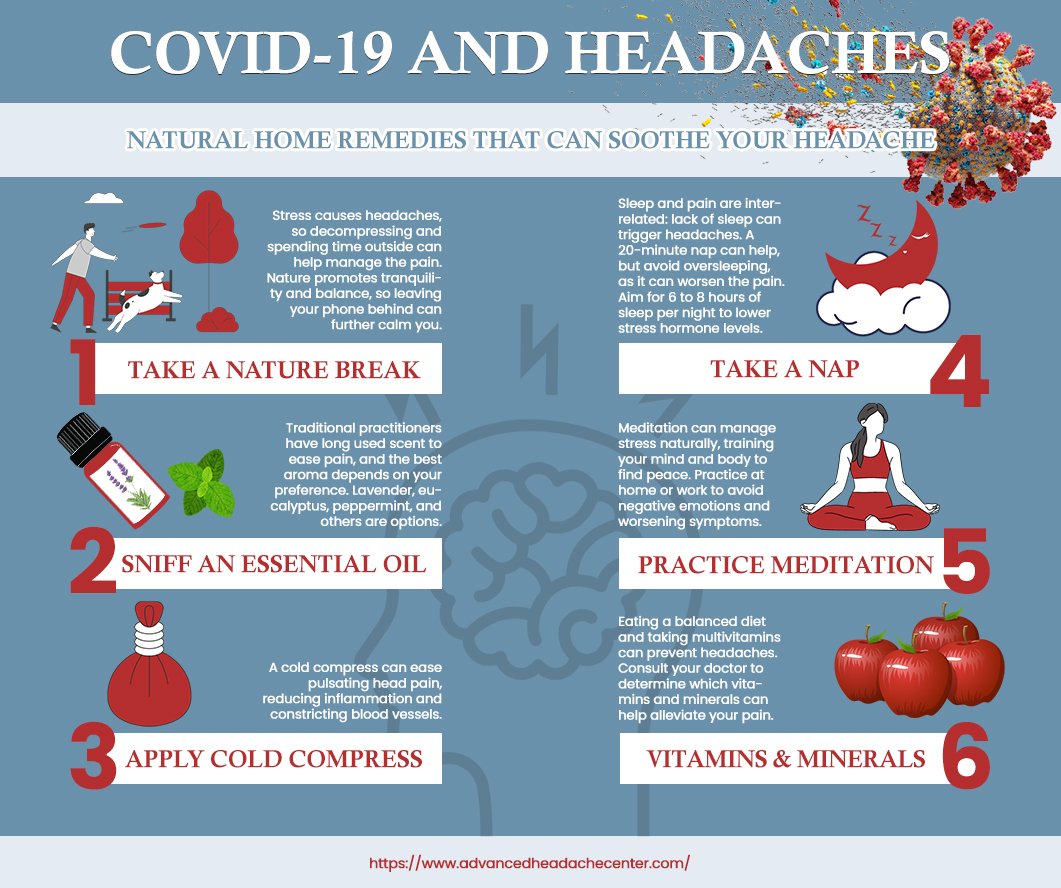While the loss of taste and smell, dry cough, and sore throat are the more publicized symptoms of sars-cov-2, headaches are also common and might possibly be the worse symptom as they can linger long after the disease is gone from your body. According to the American Migraine Foundation, about half of all people with an acute COVID-19 infection experience a headache.
So why does COVID cause lasting headaches? The cause may be attributed to the SARS-CoV-2 binding on the trigeminal nerve, as well as damage in the olfactory pathway. This may also be the reason why patients lose their sense of taste and smell. Take note, however, that a severe headache may also be indicative of other health conditions such as stroke or viral meningitis.
The Connection Between COVID-19 and Headaches
Researchers still have a lot of ground to explore when it comes to COVID-induced headaches. One possible explanation for its instigation is microvascular injury: COVID-19 negatively affects blood vessels which, in turn, affects the largest cranial nerve called the trigeminal nerve. This nerve in particular is responsible for facial sensations and motor activities.
Another explanation is damage in the olfactory pathway. Sometimes patients lose their sense of taste and smell alongside headaches. Since COVID enters the body through the nose, it causes inflammation in the nasal cavity which then activates the trigeminal nerve branches that trigger headaches.
What differentiates a COVID-19 headache and a migraine attack is its cause. A migraine is a primary headache, meaning it gets caused by changes in nerve signaling and neurotransmitter levels. Genetics and environment can also be a factor. COVID-19 headache, on the other hand, is a secondary headache. It’s caused by an underlying health condition which, in this case, is the coronavirus.

How a COVID-19 Headache Feels
Even if you’re no stranger to headaches, COVID-induced pain varies per patient. For some, the pain in their skull is so debilitating that they consider going to an emergency room. Others feel throbbing waves; some feel a constant ache, and there are those that described it as a “living hell” and a 20 out of 10 pain level.
The typical characteristics of COVID headaches include:
- Moderate to severe intensity
- Bilateral head pain
- Difficult to ease with over-the-counter medications like Tylenol, Advil, and Motrin
3 types of headaches can occur with a COVID infection: migraine-like, tension-type, and daily persistent headaches. Figuring out which one you have is crucial to determining the right treatment.
Patients with a migraine-like headache usually report throbbing, nausea, and sensitivity to sound and light. Those with tension-type headaches feel a rubber band-like restriction across their head. As for the third type, a COVID headache is diagnosed as a daily persistent headache if it lasts for more than 90 days, although doctors can usually recognize it and begin treating it way earlier.
Why Some COVID Headaches Last Longer Than the Illness
The median duration of COVID headaches is more or less 14 days; however, some patients have it for a few months. The worse the headache is during acute infection, patients were more likely to experience it for a longer period of time. It also “waxes and wanes” just like other COVID-19 symptoms.
While some patients’ headaches go away along with the illness, others find it hard to shake off – even when their other coronavirus symptoms have disappeared. If you have persistent headaches, you might have a long COVID headache, also known as post-COVID headache. You might want to check in with a headache specialist as soon as you can. You don’t want headaches ruling your life and interfering with your day-to-day activities.
It isn’t well understood why some headaches don’t quit, even if you’re no longer infected with COVID. Some possibilities include high blood pressure, further complications, and rising pandemic stress. The good news is that there are numerous treatments for long-lasting headaches, depending on the diagnosis. As experts in headaches, Advanced Headache Center can guarantee that you don’t have to have to feel this pain forever.
Advanced Headache Center: Integrative Treatments for Headache Relief
When headaches disrupt your daily life, you need to see a healthcare provider that has specialized expertise in headaches. Fortunately, Advanced Headache Center understands headaches like no one else. Our doctors have years of experience and can treat the debilitating effects of headaches.
We also offer state-of-the-art integrative headache treatments uniquely designed for our patient’s needs:
| Headache Treatment | Description |
| Multimodal Approach | As the name implies, this headache treatment offers multiple modalities of treatment, specifically pharmacological and non-pharmacological. Since headaches manifest as a pain condition, increased use of medications may lead to unwanted effects. Thus, multiple modalities should be used as effective preventative measures and pain relief solutions. |
| Rational Polypharmacy | Rational polypharmacy refers to the use of more than one type of medication – usually opioids or opiates – to manage headaches, especially when the pain is chronic. This is recommended by headache specialists who’ve determined a personalized plan for patients, making sure that there will be no adverse effects and it will not be creating dependency. But note that this particular treatment does not take into account drug addiction. |
| Trigger Points Injection | Trigger points are areas in the muscle that is tight, very irritable, and can be responsible for chronic headaches. It may produce pain not only in the affected muscle but even referred pain in distant areas. A trigger point injection can reduce the sensitivity of muscle fibers via a local anesthetic and thus relieve the pain both in the affected muscle and in the area of referred pain. |
| Occipital Nerve Blocks | The greater and lesser occipital nerves may contribute to a headache disorder and so blocking or numbing them would mean blocking the pain signals and reducing chronic headaches. Occipital nerve blocks refer to the procedure where the doctor injects a combination of pain-relieving medication and steroids in the back of your head to decrease inflammation and pain. The effects tend to be temporary. |
| Intravenous Infusions | Intravenous medication infusions (IV therapy) are a safe and painless headache management strategy. When used in an ambulatory setting, it is a cheaper alternative to emergency department care. IV therapy can end refractory headaches by making use of magnesium and by detoxifying medication overuse. Since it provides hydration, electrolytes, and vitamins directly to the bloodstream, it offers faster relief compared to oral medications. |
| Sphenopalatine Ganglion Block | The trigeminal nerve, also known as the main nerve involved in headaches, is associated with the sphenopalatine ganglion (SPG), a collection of autonomic nerves and sensory nerves. Blocking the SPG entails a minimally invasive procedure that inhibits pain transmission in the ganglion and controls facial pain. Patients typically require a series of injections – sometimes 2, while others need more than 10. |
| Physical Therapy | Physical therapy is an effective treatment option as it can decrease the intensity, duration, and frequency of your headaches. It also helps improve ease of motion in the neck and consequently your quality of life. It can treat headaches rooted in musculoskeletal issues such as muscle tension and tightness, poor posture, and tightness between shoulder blades. |
| Chiropractic Care | Chiropractic adjustments can decrease and resolve acute and chronic head pain – whether that’s a migraine headache, tension-type headache, or another kind. Whether you’re spending hours driving on the road or you’re seated in your office job for hours on end, stress can manifest in your body and later lead to headache pain. Using the targeted methodology, the chiropractor adjusts the alignment of your spine to alleviate stress on your nervous system. |
| Acupuncture | Acupuncture is a traditional form of Chinese medicine that divides your body into zones and pressure points. Hair-thin needles are inserted near nerves to stimulate the release of various hormones, such as endorphins, to trigger the body’s healing response and to promote a feeling of relaxation. This stimulation is claimed to relieve headaches. Pain is not experienced during an acupuncture session. |
Natural Home Remedies
Here is a list of home remedies that can soothe your headache. Keep in mind that these natural solutions and medications bring only temporary relief; it takes more than popping a pill to fight your headache’s trigger. We highly recommend pairing these with medical treatments from Advanced Headache Center for the best results.
1) Take a Nature Break
Stress is the leading cause of headaches, so finding ways to decompress, chill out, and wind down is a good pain management strategy. And one of the best things you can do for yourself and your mental health is to spend some time outside. Bask in nature’s ability to promote tranquility and balance. As much as possible, don’t bring your phone as the notifications and pings won’t exactly calm you.
2) Sniff an Essential Oil of Your Choice
Since time immemorial, traditional practitioners have relied on the power of scent to ease the pain. Which aroma works best depends on your preference. You get to choose from an array of options including lavender, eucalyptus, peppermint, and the like. Don’t forget to avoid touching your eyes while applying the essential oil.
3) Apply Cold Compress
Just like with a sore shoulder or ankle, a cold compress can ease the pulsating pain in your head. It reduces inflammation and constricts your blood vessels which may take away the pain from a headache. The icy sensation also helps deviate your attention away from the pain.
4) Take a Nap
Sleep and pain have a two-way relationship. Sleep deprivation can trigger headaches and so don’t be afraid to take that 20-minute nap. Just remember to not extend or hit that snooze button because you might wake up groggy and in worse pain than before you closed your eyes. Also, try to sleep between 6 to 8 hours per night to decrease stress hormone levels.
5) Practice Meditation
Meditation is a natural alternative for stress management. It trains your mind and body to attain a peaceful state. The best part is that you can practice meditation at home or at work so that you never have to feel negative emotions for a long time. It pays to keep yourself relaxed as you don’t want to exacerbate your headache or any other COVID-19 symptom that you may have.
6) Vitamins and Minerals
In addition to consuming a healthy, balanced diet, adding multivitamins in the mix can ensure that your body gets all the substances it needs and prevents any impending headaches. Consult your headache doctor on which vitamins and minerals are appropriate for relieving your pain.
COVID-19 Vaccination and Headaches
Headaches are one of the reported side effects of all COVID-19 vaccines, as well as other common vaccinations like the flu shot. It’s a transient side effect, subsiding within a day or 2, which can be eased by over-the-counter painkillers.
Other potential side effects of COVID-19 vaccines are injection site pain, muscle pain, fatigue, chills, and a fever. Don’t worry though as these effects are short-lived – they can last 24 to 72 hours and then eventually subside. They also occur more commonly after the second dose; however, even if you experienced side effects after the first dose, you should not skip or delay the second shot.
None of these side effects should discourage you from getting vaccinated because they’re actually effective indicators that you’re developing a good immune response to the vaccine. Headaches aside, getting infected by the coronavirus poses more risks to your life, health, and the safety of those around you.
Other Possible Causes of Your Headache
Headaches are a common complaint, but they are more complicated than most people realize. At this point, you might be wondering if your headache is a symptom of COVID or a result of something else. It differs from a migraine attack since it may occur with a fever, but it doesn’t happen with other common migraine symptoms.
Currently, the exact characteristics of a COVID-induced headache is poorly defined and so it is difficult to distinguish one from another. You would need to consult your doctor with regard to the root of your headache because remember, there are 150 types of headaches. Some are often set off by other illnesses, sleep deprivation, hunger, caffeine withdrawal, and certain food and drinks.
Manage Headaches Amid COVID-19 at Advanced Headache Center
Headaches are a common symptom of COVID; however, it’s less common than other symptoms such as fever, fatigue, and shortness of breath. It can last for several months, most especially if the patient develops post-COVID-19 syndromes (long COVID). Advanced Headache Center offers integrative treatments to soothe and relieve the pain – whether the root cause is COVID or another illness. Schedule a consultation today.




